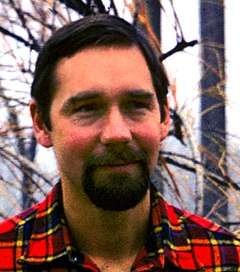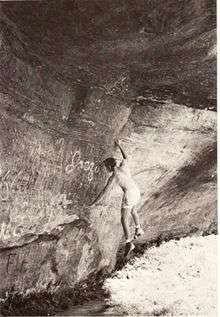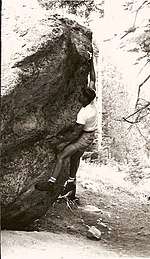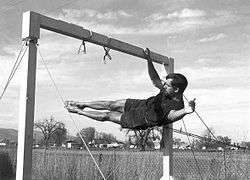John Gill (climber)
John Gill (born 16 Feb 1937) is an American mathematician who has achieved recognition for his rock-climbing. Many climbers consider him the father of modern bouldering.[1][2][3]
 John Gill in 1968 | |
| Personal information | |
|---|---|
| Nationality | American |
| Born | February 16, 1937 |
| Website | www |
| Climbing career | |
| Type of climber | Bouldering |
| Updated on 12 December 2015. | |
Early life and professional career
As a child, Gill lived in several southern U.S. cities, including Atlanta, Georgia, where he graduated from Bass High School in 1954. He attended Georgia Tech university from 1954 to 1956, and graduated from the University of Georgia with a degree in mathematics in 1958. He entered the U.S. Air Force as a second lieutenant, and also attended a special graduate meteorology program at the University of Chicago in 1958 and 1959. He was assigned to Glasgow AFB in Montana until 1962, and resigned from the USAF Reserves as a captain several years later.
After obtaining a master's degree in mathematics from the University of Alabama in 1964, Gill became an instructor at Murray State University from 1964 to 1967. In 1967 he enrolled as a graduate student at Colorado State University, and received his PhD in classical complex analysis in 1971. His dissertation on Möbius transformations was supervised by Arne Magnus.[4]
During his career as a college professor, Gill wrote approximately thirty research papers on the analytic theory of continued fractions, complex functions, linear fractional transformations, and related topics.[5][6][7][8] He also started a minor mathematical journal entitled Communications in the Analytic Theory of Continued Fractions with John McCabe of St Andrews University.[9][10] Gill retired as professor of mathematics from the University of Southern Colorado in 2000.[11]
Bouldering

John Gill began mountain and rock climbing in 1953 as a traditional climber. By the mid-1950s he had begun to specialize in very short, acrobatic routes on outcrops and boulders, establishing problems in the 1950s and early 1960s considerably harder than those existing at the time.
Being a gymnast and thinking of climbing as an extension of gymnastics rather than hiking, in the mid-1950s he introduced the use of gymnastic chalk into American rock climbing. The use of chalk then spread internationally throughout the climbing world. At the same time he introduced controlled dynamics, recommending it as a technique of choice, as well as one of necessity. According to Alpinist magazine, "his introduction of chalk and dynamic movement marked the beginning of modern climbing in America."[12]
Gill's climbing style showed the influence of formal gymnastics. He emphasized form and grace of motion over simple efficiency, the cornerstone of contemporary climbing. His performances, as recorded on film taken when he was forty (Disciples of Gill, 2009), demonstrate straight lines and minimal contact with the rock. He preferred an application of strength and sometimes avoided efficient moves like the heel hook, which he considered unaesthetic. Gill's approach to bouldering – artistic style being on par with difficulty – was rarely followed by climbers of his generation and is considered unusual today, difficulty remaining paramount. He also practiced bouldering as a form of moving meditation.[11]
Although certainly not the first serious boulderer — his notable predecessors include Oscar Eckenstein (1859–1921) and Pierre Allain (1904–2000) — Gill was probably the first climber in the history of rock climbing to make bouldering his primary specialty and to advocate acceptance of bouldering as a legitimate sport in its own right. His focus on bouldering and the high difficulty level climbs he established inspired a number of traditional climbers to take a more serious view of the sport, which, for the most part had been seen merely as training for longer roped climbs.
After retiring, Gill spent several years researching the origins of rock climbing, particularly bouldering. He also compiled a chronicle of bodyweight feats associated with climbing. These results, along with a history of gymnastic rope climbing, may be found on his website.[13]
Gill received the 2008 American Alpine Club's Robert & Miriam Underhill Award for outstanding climbing achievement.[14]
Early climbs

In the Tetons, in 1958, John Gill climbed a short route on Baxter's Pinnacle that lies in the 5.10 realm, before that grade was formally recognized — one of the first to be done in America.[15] By the end of the 1950s, Gill had reached what would now be considered V9 levels on a few eliminate boulder problems. (He later stated he probably never progressed beyond V10 throughout his climbing career.[13]).
Two of his problems on Red Cross Rock in the Tetons — a V8 in 1957 and a V9 in 1959 — set new standards of bouldering difficulty. And his 1961 route on a steep face of a small granite spire named the Thimble[16] (Needles of South Dakota) — an unrehearsed and unroped 30-foot 5.12a free-solo climb (or V4 or V5 highball)— is considered one of the great classics of modern climbing, and — if considered a climb (as Gill did) — may well be the first at the 5.12 grade.[15][17] Gill climbed the route without the benefit of modern climbing shoes, significantly increasing the difficulty of the climb.
"B" Grading system
In the 1950s, John Gill introduced a very early – if not the first – grading system specifically designed for bouldering and not restricted to a particular area.[1] The system, (B1, B2, B3), had two subjective levels of difficulty, and one objective level, and was predicated on prevailing and future standards attained in traditional rock climbing. The introduction of sport climbing some twenty years later and more intense competition weakened the philosophical underpinnings of the three-tiered structure, although climbers such as Jim Holloway adopted personal three-level systems similar to Gill's. Today, Gill's B-system is rarely used, abandoned in favor of open-ended grading systems such as the V-scale.
Gymnastics and strength exercises

As an amateur gymnast in the 1950s, 6'2" and 180 pounds, Gill specialized in the competitive rope climb and the still rings, achieving a time of 3.4 seconds for the 20' rope climb (from seated position on the floor, arms only) and accomplishing a number of difficult stunts on the rings, including inverted and olympic crosses, giant swings, and slow pulls from hang to handstand. He also engaged in what are now called bodyweight exercises similar to gymnastics, achieving seven one-arm pullups with the right arm and five with the left, several one-finger one-arm pullups, one-arm pullups carrying twenty pounds, one-arm pullups on a one-half inch ledge, and one-arm front levers.[13][18]
Further reading
- Ament, Pat (1977). John Gill:Master of Rock. Alpine House Publishing.
- Gill, John (1969). "The Art of Bouldering", American Alpine Club Journal.
- Gill, John (1986). "Reflections of a Middle Aged Boulderer", Mountain Magazine#107
- Horst, Eric (2003). Training for Climbing. Falcon Guide. Globe Pequot Press.
- Krakauer, Jon (1990). Eiger Dreams, Chap. 2 – Gill. Lyons & Burford Press.
- Sherman, John (1994). Stone Crusade, Chap.1 - John Gill & the Birth of Modern Bouldering. American Alpine Club Press.
Magazine articles & interviews
- Climbing(1976,1996,2000)(USA)
- Mountain(1977,1986)(Britain)
- Iwa To Yuki(1984,1992)(Japan)
- New Age Journal(1985)(USA)
- High(1986)(Britain),Outside(1989)(USA)
- Rock&Ice(1993,1997,2005))(USA)
- Flash Communique(1993)(USA)
- Roc’NWall(1995)(France)
- VBouldering(1995)(USA)
- Math Horizons(1997)(USA)
- RotPunkt(2000)(Germany)
- Klettern(2003)(Germany)
- GÓRY(2003)(Poland)
- Montana(2003)(Czech Republic)
- Outsider(2004)(Ireland)
- Alpinist(2005)(USA)
- Campobase(2006)(Spain)
- Urban Climber(2006)(USA)
- Hoogtelijn(2007)(Netherlands)
- Climb(2007)(Britain)
- Rock&Snow(2015)(Japan)
References
- Sherman, John (1994). Stone Crusade: A Historical Guide to Bouldering in America, American Alpine Club Press.
- "Interview with John Gill - bouldering legend". Three Rock Books. Retrieved 2020-07-21.
- "Why math brains fall for rock climbing". Futurity. 2010-07-28. Retrieved 2020-07-21.
- John Gill at the Mathematics Genealogy Project
- J. Gill, "Infinite Compositions of Möbius Transformations", Transactions of the Amer. Math. Soc., Vol. 176(1973)
- J. Gill, "Attractive Fixed Points and Continued Fractions", Mathematica Scandinavica, Vol. 33
- J. Gill, "Use of Attractive Fixed Points to Accelerate the Convergence of Limit Periodic Continued Fractions", Proc. Amer. Math. Soc., Vol. 47
- "John Gill". ResearchGate. Retrieved 2020-07-22.
- "History of CATCF". Colorado Mesa University. Retrieved 2018-01-07.
- "John Gill: Career as a Teacher and Mathematician". Retrieved 2018-01-07.
- Ament, Pat (1998). John Gill:Master of Rock. Climbing Classics #2, Stackpole Books
- Editors,Alpinist Magazine #12, 2005
- gill, john. "john gill's website". www.johngill.net.
- "The Robert and Miriam Underhill Award". The American Alpine Club.
- >Ament, Pat (2002). Wizards of Rock: A History of Free Climbing in America, Wilderness Press
- Video on YouTube
- Climbing Magazine, Millennium Special, March (2000)
- Video on YouTube
External links
| Wikimedia Commons has media related to John Gill (climber). |